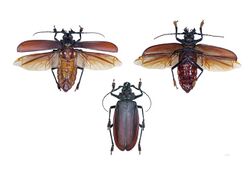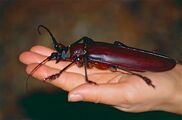Biology:Titan beetle
| Titan beetle | |
|---|---|

| |
| Titanus giganteus | |
| Scientific classification | |
| Domain: | Eukaryota |
| Kingdom: | Animalia |
| Phylum: | Arthropoda |
| Class: | Insecta |
| Order: | Coleoptera |
| Infraorder: | Cucujiformia |
| Family: | Cerambycidae |
| Subfamily: | Prioninae |
| Tribe: | Prionini |
| Genus: | Titanus Audinet-Serville, 1832 |
| Species: | T. giganteus
|
| Binomial name | |
| Titanus giganteus (Linnaeus, 1771)
| |
| Synonyms | |
|
(Genus)
(Species)
| |
The titan beetle (Titanus giganteus) is a Neotropical longhorn beetle, the sole species in the genus Titanus, and one of the largest known beetles.
Description
The titan beetle is one of the largest beetles, with the largest reliable measured specimen being 16.7 cm (6.6 in) in length,[1] comparable to such beetles as the giant Fijian long-horned beetle, Xixuthrus heros (15 cm (5.9 in)), and the Hercules beetle, Dynastes hercules, in which giant males occasionally can grow up to 17.5 cm (6.9 in),[2] but the Hercules beetle males have an enormous horn on the pronotum or thorax making up around half of its total length. As such, the body of the Titan beetle is considerably larger than that of the Hercules beetles. The short, curved and sharp mandibles are known to snap pencils in half and cut into human flesh.[3] Adult titan beetles do not feed,[citation needed] searching instead for mates via pheromones while in flight.[4]
The larvae have never been found, but are thought to feed inside wood and may take several years to reach full size before they pupate. These beetles are also thought to feed on decaying wood below the ground. Boreholes thought to be created by titan beetle larvae seem to fit a grub over two inches wide and perhaps as much as one foot long. A famous "life-sized" photograph of a putative larva of this beetle appeared in National Geographic magazine, filling an entire page,[3] but it turned out to be of a different species of beetle, possibly Macrodontia cervicornis.
The adults defend themselves by hissing in warning and biting, and have sharp spines, as well as strong jaws. The adult beetles central nervous system structure shown that the cephalic ganglion is composed of the central brain and optic lobes that connect to the sub esophageal ganglion (SOG). This is a common structure for diurnal insects. The size of the size sensory integration were larger complex eyes that have structured large optic and antennal lobes.[5] [3]
Distribution
It is known from the rain forests of Venezuela, Colombia, Ecuador, Peru, the Guianas, and north-central Brazil.
Gallery
See also
- List of largest insects
References
- ↑ Williams, David M. (2001). "Chapter 30: Largest". in Walker, T.J. University of Florida Book of Insect Records. http://entnemdept.ufl.edu/walker/ufbir/chapters/chapter_30.shtml.
- ↑ Ratcliffe BC, Cave RD. 2015. The dynastine scarab beetles of the West Indies (Coleoptera: Scarabaeidae: Dynastinae). Bulletin of the University of Nebraska State Museum 28: l-346.
- ↑ 3.0 3.1 3.2 Zahl, P. A. (1959): Giant insects of the Amazon. Natl. Geogr. Mag. 115 (5): 632-669.
- ↑ "Titan Beetle". Smithsonian. May 31, 2011. https://www.si.edu/newsdesk/snapshot/titan-beetle.
- ↑ Dvořáček, Jiří; Sehadová, Hana; Weyda, František; Tomčala, Aleš; Hejníková, Markéta; Kodrík, Dalibor (2020). "First Comprehensive Study of a Giant among the Insects, Titanus giganteus: Basic Facts from Its Biochemistry, Physiology, and Anatomy". Insects 11 (2): 120. doi:10.3390/insects11020120. PMID 32059419.
External links
- Titanus giganteus pictures at Bio-Foto.com
- Video clip of the Titan beetle from Life in the Undergrowth
- Giant beetle visits Oxford University
- BBC news article with photograph
- BBC article which covers the beetle's grubs
- Natural History Museum page about Titanus giganteus
- https://www.kidsdiscover.com/quick-reads/34551/
Wikidata ☰ {{{from}}} entry
 |





